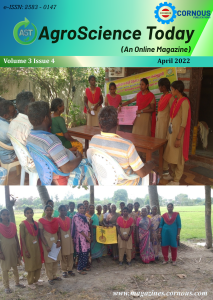Food safety is of major concern in any of the food processing industries as most of the freshly packed foods are subjected to microbial attack leading to growth of microorganisms. Growth of microbes leads to change in taste, smell, odour of packaged foods which is the huge loss for food industries as it is unfit for consumption. Therefore, there is need to identify and detect these microbes thus ensuring food safety. Several conventional methods are available, but all these methods are time consuming and laborious. But in recent years MALDI-TOF mass spectrometry is gaining popularity because it is more accurate, rapid method of microbe detection and identification.
Moringa is a popular vegetable for curry, gravy and side dish preparations, both leaves and fresh pods are used in culinary purposes. The important breeding objectives in moringa are development of short statured drought and saline tolerant annual types with higher number of pods and higher levels of iron and zinc. Besides these, off season production is also one of the important breeding objectives. Applications of conventional breeding approaches in Moringa are very difficult due to its highly cross pollinated nature and heterozygosity expressions. Hence, biotechnological approaches are the best option for further improvement of Moringa. Micro-propagation and Doubled haploid techniques will pave the way for genetic improvement in Moringa for genetic uniformity.
The coconut tree is the only living species of the genus Cocos from the family Arecaceae. It is cultivated widely in tropical areas for its edible fruit called the coconut. The term "coconut" can refer to the whole coconut palm, the seed, or the fruit, which is botanically as drupe, not a nut. Coconut palms are found in tropical coastal areas and its being one of the most predominant crops of the tropics. The countries like Philippines, India and Indonesia are the major copra producers in the world. Coconuts are mostly cultivated for their oil. The oil is extracted from the endosperm and is used for cooking. Coconut is a source of food, beverages, medicine, natural fiber, wood and raw materials for units producing a variety of goods and items. The assessment of crop loss is necessary for sensible planning for making research and developmental policies. Coconut crop yield losses due to insect pests particularly Opisina arenosella, it can be as high as 45% and it will take upto 4 years to regain normal yield after heavy infestation.
Rural Horticultural Work Experience (RHWE) is a course offered to the undergraduate students to get associated with the farmers community and to understand the agricultural / Horticultural conditions in the rural areas. In this programme students performs some demonstrations related to the farm practices. Here we have performed 10 demonstration viz., Demonstration of zero energy cool chamber, Seed ball technique, Soil sample collection, Coconut mulching, Compost preparation, Air layering technique, Intercultural practices in banana, Kitchen gardening, Organic pesticides making, and Kisan call centre at various places in kaveripakkam village. This supports the farmers to gain a good knowledge about farm practices using low cost investment.
The Major contribution of the agriculture income is to uplift the livelihood status of the farmers. Many farmers are running behind the various government and non-government organizations every season in search of good services and information. However, in view of large gap between production and supply, some of the farmers are resorting to locally available Advisories. Hence, adoption of Integrated farming system to production under the supervision of extension personal approach can improve farmers’ income besides ensuring the good quality life style. This article narrates how the resource poor farmer to produce high number farm activities to double the farmer’s income as compared to that of normal agrarian.
